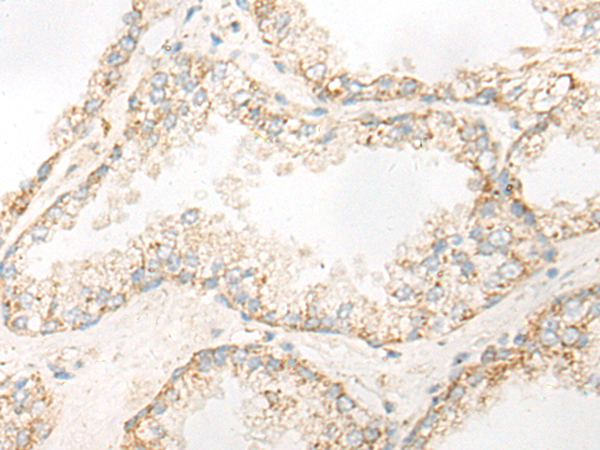

| WB | 咨询技术 | Human,Mouse,Rat |
| IF | 咨询技术 | Human,Mouse,Rat |
| IHC | 1/20-1/100 | Human,Mouse,Rat |
| ICC | 技术咨询 | Human,Mouse,Rat |
| FCM | 咨询技术 | Human,Mouse,Rat |
| Elisa | 1/5000-1/10000 | Human,Mouse,Rat |
| Aliases | SCDO1 |
| Host/Isotype | Rabbit IgG |
| Antibody Type | Primary antibody |
| Storage | Store at 4°C short term. Aliquot and store at -20°C long term. Avoid freeze/thaw cycles. |
| Species Reactivity | Human |
| Immunogen | Synthetic peptide of human DLL3 |
| Formulation | Purified antibody in PBS with 0.05% sodium azide and 50% glycerol. |
+ +
以下是关于DLL3抗体的3篇代表性文献,简要整理如下:
1. **《DLL3 as a therapeutic target in small cell lung cancer》**
*作者:Rudin CM, et al. (2017)*
**摘要**:该研究首次报道了靶向DLL3的抗体偶联药物Rovalpituzumab tesirine(Rova-T)在复发性小细胞肺癌(SCLC)患者中的I期临床试验结果,显示DLL3高表达患者中具有显著抗肿瘤活性。
2. **《DLL3 expression in neuroendocrine tumors and its prognostic significance》**
*作者:Saijo N, et al. (2019)*
**摘要**:通过免疫组化分析多种神经内分泌肿瘤中DLL3的表达,发现其与肿瘤侵袭性相关,提示DLL3可作为预后标志物及抗体治疗的潜在靶点。
3. **《Preclinical evaluation of anti-DLL3 antibodies for targeted therapy》**
*作者:Puca L, et al. (2020)*
**摘要**:在临床前模型中验证了靶向DLL3的单克隆抗体及双特异性抗体的抗肿瘤效果,表明其通过抑制Notch信号通路诱导肿瘤细胞凋亡。
4. **《Targeting DLL3: Mechanisms and clinical progress》**
*作者:Blaeschke F, et al. (2022)*
**摘要**:综述了DLL3靶向治疗的分子机制,总结了抗体药物、CAR-T细胞疗法及联合治疗策略的最新临床进展与挑战。
以上文献涵盖了DLL3抗体的基础研究、临床转化及综述分析,供快速参考。
DLL3 (Delta-like ligand 3) is a cell surface protein belonging to the Notch signaling pathway ligand family. Unlike other Delta-like ligands, DLL3 is an inhibitory ligand that primarily localizes to the Golgi apparatus and interacts intracellularly with Notch receptors, suppressing canonical Notch signaling. Its aberrant overexpression is strongly associated with high-grade neuroendocrine tumors, particularly small cell lung cancer (SCLC) and large cell neuroendocrine carcinoma.
DLL3 gained attention as a therapeutic target due to its tumor-specific expression in approximately 80% of SCLC cases, while remaining largely absent in normal tissues. This selectivity makes it an attractive candidate for antibody-based therapies. The most advanced DLL3-targeting agent is Rovalpituzumab tesirine (Rova-T), an antibody-drug conjugate (ADC) comprising a DLL3-specific monoclonal antibody linked to a cytotoxic payload. Despite early-phase clinical promise in SCLC, later trials showed limited efficacy and toxicity concerns, halting its development.
Current research explores alternative strategies like bispecific antibodies (e.g., Tarlatamab) and DLL3-targeted CAR-T therapies. DLL3 also serves as a potential biomarker for patient stratification. Challenges remain in optimizing therapeutic windows and overcoming tumor heterogeneity. The unique biology of DLL3 continues to drive innovation in targeted oncology approaches for neuroendocrine-derived malignancies.
×